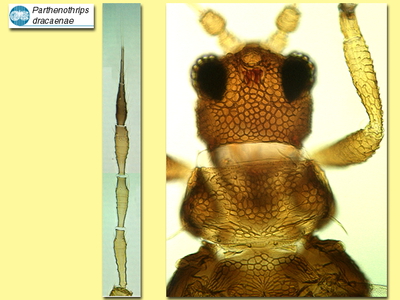Figures
Fig. 1 Antenna, head and pronotum
Fig. 2 Meso- and metanotum
Fig. 3 Fore and hind wing
Species
Parthenothrips dracaenae Heeger
Biology
Adults and larvae feed on the leaves of numerous greenhouse and household plants, particularly the Parlour Palm, Chamaedorea.
Distribution
Widespread around the world in the sub-tropics and in greenhouses, the area of origin is probably either Africa or South America.
Recognition
Large dark brown thrips with pale forewings bearing two short dark cross bands. Antennae 7-segmented, terminal segment long and slender; segments III & IV with a short simple sense cone. Head and pronotum strongly reticulate; pronotum with one pair of long, flattened posteroangular setae. Forewings exceptionally broad with reticulate surface, each major veinal seta flattened like a feather. Abdominal tergites weakly sculptured.
Related species
The only member of its genus, no other thrips species has the forewings similar in structure.




